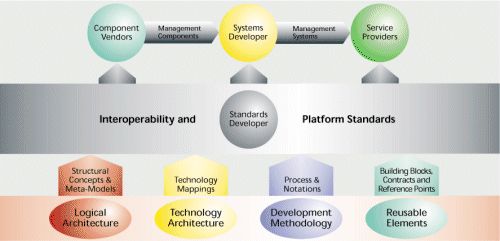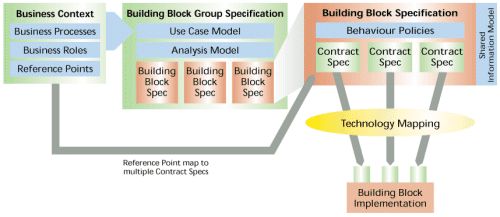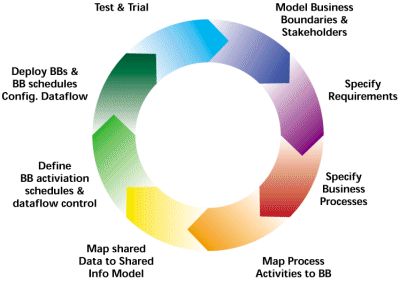FORM's goal is an Open Development Framework
(ODF) for an
emerging market in component-oriented communications management software. This
Framework is being generated with a focus on the management of
business-to-business services over QoS enabled IP networks. Such services are
termed Inter-Enterprise Services in FORM. The project is developing prototype
IES Management Systems that exercise the principles and techniques expressed in
the Framework allowing them to be evaluated and refined.

These Challenges describe the industry problems being
addressed by FORM.
Value Chains
FORM is focussed on the problems found at the junction of
two value chains. The Service Provision chain presents challenges in enabling
different services providers to collaborate in seamless service management in an
environment of dynamic market structure, network capabilities and customer
requirements. The System Development chain must address the challenges of
integrating separately-sourced software to satisfy rapidly changing management
system requirements.
Service Provision
Chain
Enterprises must be able to create, reconfigure and
dissolve business collaborations at an accelerating pace. The IES scenario
examined in FORM addresses how an IES Provider may manage the dynamic
relationships and the quality of service of electronic business interactions
between groups of enterprises, the ASPs they use and the ISPs providing
communications infrastructure.
System Development
Chain
The software industry is moving towards the (re)use of
component-oriented off-the-shelf software and
model-driven approaches. Applying this to the market for communication
management software requires new architectural and modelling principles to be
shared between Standards Bodies, Independent Software Vendors, System Developers
and System Customers (i.e. the Service Providers).
Technology Challenge
The communications management industry has moved from using
just management specific protocols (e.g. SNMP, CMIP, TL1) to encompassing more
general distributed system platforms (e.g. CORBA, COM+) and web technologies
(e.g. HTTP, XML). As a result management system development rarely avoids the
need to interwork between different technologies and to integrate and maintain
the models in multiple formats (e.g. SMI, GDMO, IDL).
Integration
Challenge
Integration of separately-sourced software has often relied
solely on the expression of well-defined interfaces. However, such interface
definitions often omit important contextual assumptions or are optimised for
implementation in a specific technology. This makes maintaining interoperability
between separately-sourced components increasingly expensive as system
requirements, technology base and component capabilities evolve over time.
These Guidelines make up the Open Development Framework.
Open Development
Framework
The Open Development Framework is the primary output of
FORM and is intended to provide guidance to industry practitioners involved in
developing software components and systems for the communications management
sector. The Framework is structured into four parts: a Logical Architecture, a
Technology Architecture, a Development Methodology and a Set of Reusable
Elements.

The Logical Architecture describes the structural concepts
of the Framework in a manner independent of any implementation technology. The
core concept is the software Building Block (BB), which exists in one of the
three computing tiers and which implements a number of Contracts via which
inter-BBs interactions occur. Systems are described in terms of business
processes and business roles. Reference Points (RP) exist between Business Roles
and are decomposed in RP Segments. RP Segments are realised through Contract
implementations.
 The Development Methodology provides the processes and
notations needed to develop components and assemble systems that conform to the
Framework. The primary modelling notation used is UML, though the potential of
XML for Contract specification is also being examined. The methodology
integrates a number of existing modelling techniques such as use case modelling,
business process modelling and analysis modelling plus the variety of other
modelling approaches supported by UML.
The Development Methodology provides the processes and
notations needed to develop components and assemble systems that conform to the
Framework. The primary modelling notation used is UML, though the potential of
XML for Contract specification is also being examined. The methodology
integrates a number of existing modelling techniques such as use case modelling,
business process modelling and analysis modelling plus the variety of other
modelling approaches supported by UML.
The Technology Architecture addresses how the concepts
expressed in the Logical Architecture can be implemented using a range of
technologies. For each technology, a single mapping between the meta‑model
for technology neutral Contract specification and the native meta-model of the
technology, is sought. Adaptation
to allow interoperability between Contracts implemented in different
technologies is also addressed.
This portion of the Framework is the repository for
reusable products that result when the Framework is applied to a particular
application domain, e.g. the IES Management domain addressed in FORM. The
principle types of reusable entities are: Business Role definitions; Reference
Point Segment specifications and their grouping into Reference Points; Contract
specifications and their grouping into BB Specifications and BB implementations.
Other types of reusable elements, such as policy and business process
definitions are also being investigated.
These are the concrete solutions developed in the project
that provide examples of the application of the Framework in the IES domain.
Some of these solutions are based on interests external to the Framework and may
therefore be presented as such.
IES Management
Framework
The IES Management Framework represents the application of
the Open Development Framework to the IES Management problem domain. It provides
a medium through which FORM evaluates the concepts of the Open Development
Framework and aims to provide guidance and reusable specifications and software
products to industry practitioners in the IES domain. Portions of the IES
Management Framework are being implemented and evaluated in a number of trials
conducted within the project.
IES Business Model
The IES Management Framework identifies specific business
roles and business processes that apply to the IES domain. The Business Roles
are identified as: IES Customer, IES Provider, ASP, VPN Provider and Guaranteed
QoS IP Provider. A set of Reference Points has been identified between these
roles and is being populated with Segment definitions derived from business
process models and analysis models of domain requirements that have been
gathered during the project.
IES Development Case
Definitions of software development processes and
notations, as defined in the Open Development Framework, are often difficult for
software developers to apply . The analysis and design work conducted in
implementing portions of the IES Management Framework are being distilled into a
Development Case, which provides a detailed worked example of the application of
the Development Methodology.
Technology Mappings
In implementing portions of the IES Management Framework,
several technology mappings and technology adapters are being developed. The
primary technology mappings involve CORBA, EJB and XML, with several approaches
being evaluated to assess their relative merits. An XML-CMIS adaptation function
has been implemented and adaptation with SNMP and WBEM are also under
investigation.
IES Building Block
Sets
The implementation of the IES Management Framework is
resulting in several BB Sets that address different business process areas in
the IES domain. These BB Sets include: SLA Negotiation, Subscription Management,
CPE Security Management, Federated Inter-Domain Accounting Management, VPN
Configuration Management, IP DiffServ QoS Assurance and Application Level
Service Assurance.
FORM is developing an Open Development Framework to guide
the developers of component-based management systems. This Framework is based on
the experience garnered from previous EU projects and standardisation work on
component-oriented or management-related architectures, including J2EE, the work
of the TM Forum's Application Component Team and the NGOSS initiative, the
DMTF's CIM and the TINA-C's Service and Business Models, amongst others.
FORM is taking a build-and-learn approach to evaluate and
refine this Framework, by applying it to the challenges presented by assembling
value chains in the Inter-Enterprise Services domain. As a result the
presentation of the architectural and methodological concepts of the Open
Development Framework will be made in concert with examples and demonstrations
of their application in modelling and implementing the IES BB Sets.
